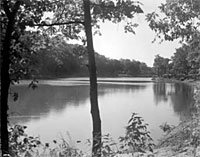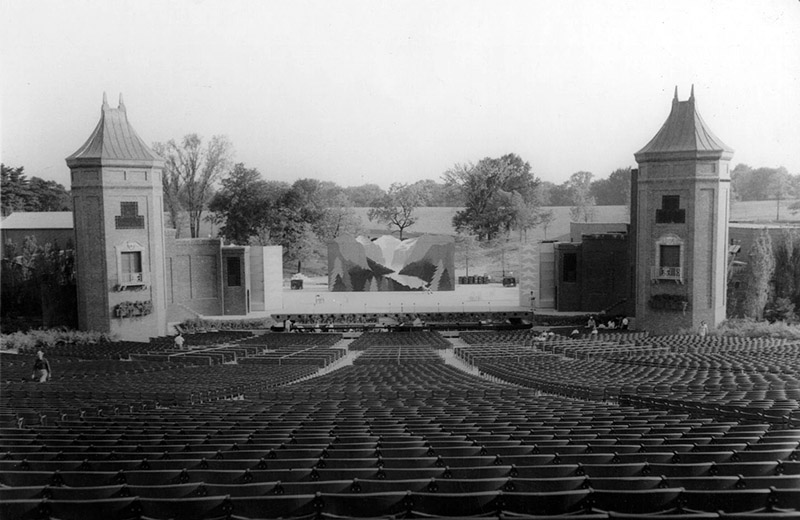Following celebrations for Kansas City's centennial birthday, Starlight Theatre began its first season on June 25, 1951, with the musical The Desert Song. Attending the outdoor theatre in Swope Park quickly became a beloved summertime tradition for many locals. Today, Starlight Theatre is one of only a handful of outdoor venues featuring touring Broadway shows.
Starlight Theatre's history began in the 1920s when the Kansas City Federation of Music Clubs advocated the construction of a theatre "under the stars." Fundraising began with the 1926 visit of Queen Marie of Romania, who had helped secure her country's support for the Allied forces during World War I. Romania had recently opened its oil fields to America's Standard Oil Company, so the queen's tour of the U.S. carried considerable diplomatic significance.
In her six-hour visit to Kansas City, Queen Marie joined President Calvin Coolidge as an honored guest at the opening ceremonies for Liberty Memorial, which was dedicated to the remembrance of World War I. Later that evening, she enjoyed a music concert held at the American Royal Building where thousands of visitors paid admission fees for the chance to see her as well as the organized festivities. The proceeds of $7,000 were earmarked for the construction of an outdoor theatre in Kansas City.
Unfortunately, Kansas City would have to wait another 25 years to enjoy outdoor theatrical performances at Starlight Theatre. The concept for an outdoor theatre gained some momentum during the 1930s, when four operas were performed outside on temporary stages. They attracted 55,000 total patrons and raised $36,000 for the trust fund. Various factions battled over the proposed locations of the venue, which included the former August Meyer residence (presently the Kansas City Art Institute) and the nearby University of Kansas City (present-day University of Missouri-Kansas City). In the meantime, Kansas City constructed Municipal Auditorium, which served as the city's premier (indoor) theatre and concert hall.

Finally, the planned 1950 Kansas City centennial celebrations necessitated an outdoor venue that could accommodate the "Thrills of the Century" spectacle that summarized the city's history to that time. The Citizens' Planning Council and the Kansas City Park Board proposed a bond issue in 1947 for $500,000, which voters approved. The Centennial Association hastened the plans with an additional $135,000 to construct a venue in time for "Thrills of the Century." Construction on Starlight Theatre, which was designed by the locally-renowned architect Edward Delk, finally commenced in December 1949 at Swope Park. Nearly 150 workers labored for six months to complete a rudimentary structure in time to host "Thrills of the Century," which dazzled guests with airplane flyovers, covered wagons, gunfire, and fireworks between June 4 and July 10, 1950.
A year later, construction at Starlight Theatre was finally completed at a total cost of $1.5 million. On June 25, 1951, it officially opened with a performance of The Desert Song, composed by Sigmund Romberg. The operetta was based on a Moroccan revolt against French colonial rule and featured a French general who unwittingly had to fight his own son: the covert leader of the rebellion. Sigmund Romberg himself appeared at the premier and declared Starlight Theatre to be the most beautiful theatre he had seen.
Since 1951, Starlight Theatre has grown from an under-funded venture to a trademark of Kansas City theatrical entertainment under the guidance of the Starlight Theatre Association of Kansas City, Inc. Famous visitors occasionally graced the stage, such as, in 1958, when Jerry Lewis performed on a temporary stage that he paid to enlarge himself. In 1964, former President Harry S. Truman, a frequent spectator at the theatre, played the role of the president in a production of Mr. President. Truman's foray into acting ended abruptly, though, when he suffered an attack of appendicitis and had to leave for the hospital at intermission.
Today, visitors can still experience music concerts and full-scale Broadway productions at Starlight Theatre, which remains one of only three self-producing outdoor theatres in the U.S. It has the largest stage and the second-largest seating capacity of these venues. Theatre goers still revel in the truly unique atmosphere that features fresh air, occasional animal noises from the nearby Kansas City Zoo, and of course, a view of the stars.
Read full biographical sketches of people associated with Starlight Theatre; prepared for the Missouri Valley Special Collections, the Kansas City Public Library:
- Biography of Richard Hill Berger (1904-1998), the first director of the Starlight Theatre, by Dory DeAngelo.
- Biography of Arthur Mag (1896-1981), lawyer and benefactor of Starlight Theatre, by Daniel Coleman.
- Biography of Edward Buehler Delk (1885-1956), architect of Starlight Theatre, by Susan Jezak Ford.
- Biography of Nell Donnelly Reed (1889-1991), dress manufacturer and Starlight Theatre board of directors member, by Barbara Magerl.
View images of people and places associated with Starlight Theatre that are a part of the Missouri Valley Special Collections:
- Cast Party at Starlight Theatre, 1950
- Crowd at Starlight Theatre, 1950
- Gloria Swanson and Mayor Kemp on stage at Starlight Theatre, 1950
- Kansas City Centennial Celebration at Starlight Theatre, 1950
- Kansas City Centennial Queen at Starlight Theatre, 1950
- Audience seating at Starlight Theatre, 1951
- Full view of stage and seating area at Starlight Theatre, 1955
- Streetcar Wheels and Advertisement for Starlight Theatre, 1955
- Gisele MacKenzie, performer at Starlight Theatre, 1956
- Bill Hayes, Gogi Grant and Larry Magill, actors in "Oklahoma" at Starlight Theatre, 1959
- Starlight Theatre party luncheon, 1960
- View of seating area and lighting tower from the stage at Starlight Theatre
- Dorothy Coulter, singer; Phillipe de Rosier, designer; Dory DeAngelo; and Richard Berger, producer; 1970s or 1980s
Check out the following books about Starlight Theatre that are held by the Kansas City Public Library:
- The Story of Starlight Theatre: The History of Kansas City’s Delightful Musical Theatre Under the Stars, by Kathleen Hegarty Thorne.
- Leaders in Our Town, by Richard B. Fowler; contains a biographical sketch of William M. Symon, business manager of the Starlight Theatre, pp. 421-424.
Read more about Starlight Theatre history at the theatre's website, including complete schedules from past seasons.
Continue researching Starlight Theatre using archival material held by the Missouri Valley Special Collections:
- Vertical File: Theatres--Starlight.
- SC63, Theatres - Starlight, 1950-1964; newsletters and brochures.
- Kansas City Centennial Association Scrapbook Finding Aid; Starlight Theatre was constructed to accommodate Kansas City's 100th anniversary.
- Dory DeAngelo Papers Finding Aid; DeAngelo was a one-time assistant to the producer at Starlight Theatre.
- Edith Lowe Peters Scrapbooks Finding Aid; includes clippings about Starlight Theatre.
References:
Rick Montgomery & Shirl Kasper, Kansas City: An American Story (Kansas City, MO: Kansas City Star Books, 1999), 278.
Kathleen Hegarty Thorne, The Story of Starlight Theatre: The History of Kansas City’s Delightful Musical Theatre Under the Stars (Eugene, OR: Generation Organization, 1993).


